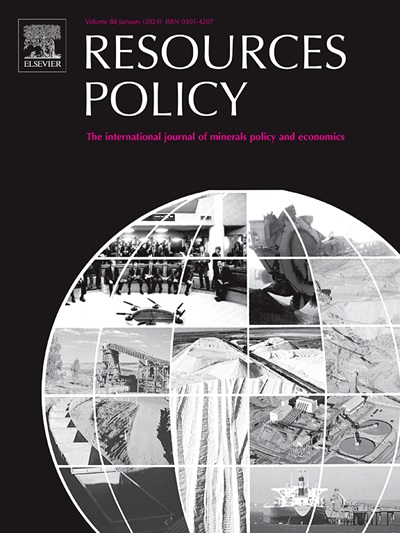AI, FinTech and clean minerals: A wavelet analysis and quantile value-at-risk investigation
IF 10.2
2区 经济学
0 ENVIRONMENTAL STUDIES
引用次数: 0
Abstract
The increasing demand for clean minerals and the rise of new-age technologies present significant challenges and opportunities for sustainable development. This study aims to explore how artificial intelligence (AI) and financial technology (FinTech) affect the exploitation of clean minerals in the pursuit of sustainable development. Employing wavelet analysis and quantile value-at-risk (QVaR), we provide a comprehensive analysis of the dynamic relationships, risks, and returns associated between clean minerals and these technological innovations. Our wavelet findings indicate that there are strong co-movements for aluminum, copper, and zinc with various clean and technological indices while nickel shows weak co-movements. Our QVaR results reveal significant differences in risk and return profiles across indices, underscoring the high-risk, high-reward nature of clean and technological sectors. These insights underscore the importance of incorporating AI and FinTech into regulatory frameworks and industry practices, advocating for a collaborative approach to leverage these technologies to influence the exploitation of clean minerals toward greater sustainability. Therefore, the novelty of this study lies in its comprehensive methodological approach to scrutinize the linkages between clean minerals and new-age technologies, with significant multi-stakeholder implications for policy and practice, aligning with the United Nations Sustainable Development Goals.
人工智能、金融科技和清洁矿产:小波分析和量化风险价值调查
对清洁矿产日益增长的需求和新时代技术的兴起为可持续发展带来了重大挑战和机遇。本研究旨在探讨人工智能(AI)和金融科技(FinTech)如何影响清洁矿产的开采,以实现可持续发展。利用小波分析和量化风险价值(QVaR),我们对清洁矿产与这些技术创新之间的动态关系、风险和收益进行了全面分析。我们的小波分析结果表明,铝、铜和锌与各种清洁指数和技术指数之间存在较强的共振关系,而镍的共振关系较弱。我们的 QVaR 结果表明,不同指数的风险和收益情况存在显著差异,这凸显了清洁技术行业的高风险、高回报特性。这些见解强调了将人工智能和金融科技纳入监管框架和行业实践的重要性,倡导采取合作方式,利用这些技术影响清洁矿产的开发,以实现更大的可持续性。因此,本研究的新颖之处在于它采用了全面的方法论,仔细研究了清洁矿产与新时代技术之间的联系,对政策和实践产生了重要的多方影响,符合联合国可持续发展目标。
本文章由计算机程序翻译,如有差异,请以英文原文为准。
求助全文
约1分钟内获得全文
求助全文
来源期刊

Resources Policy
ENVIRONMENTAL STUDIES-
CiteScore
13.40
自引率
23.50%
发文量
602
审稿时长
69 days
期刊介绍:
Resources Policy is an international journal focused on the economics and policy aspects of mineral and fossil fuel extraction, production, and utilization. It targets individuals in academia, government, and industry. The journal seeks original research submissions analyzing public policy, economics, social science, geography, and finance in the fields of mining, non-fuel minerals, energy minerals, fossil fuels, and metals. Mineral economics topics covered include mineral market analysis, price analysis, project evaluation, mining and sustainable development, mineral resource rents, resource curse, mineral wealth and corruption, mineral taxation and regulation, strategic minerals and their supply, and the impact of mineral development on local communities and indigenous populations. The journal specifically excludes papers with agriculture, forestry, or fisheries as their primary focus.
 求助内容:
求助内容: 应助结果提醒方式:
应助结果提醒方式:


